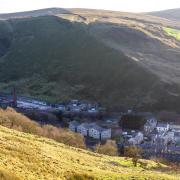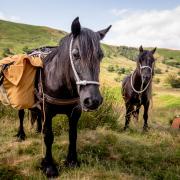Lancashire and the Lake District has an abundance of artistic talent. Sue Riley selects her top 20 but do you agree with her choice?

THE industrial north and the grandeur of the Lake District have attracted artists for centuries.
From home grown artists like LS Lowry and Sheila Fell to JMW Turner who regularly visited the area and others who decided to make it their home, it’s been a magnet for creative folk. Assembling a definitive list of the Top 20 artists associated with the area is a near impossibility – should John Harden who captured the everyday life of 18th century Brathay be included? What about maritime painter Philip Gilchrist or Thomas Moran who may have only spent the early part of his childhood in Bolton but went on to create such tremendous images of the Yellowstone National Park? Then there’s the artists currently living and working in the area: personal favourites include Silverdale’s Tracy Levine and Liam Spencer in Burnley but everyone will have their own, very different views.
Galleries across the North West have a fine collection of the area’s finest. Abbot Hall Gallery in Kendal has work by Romney, Ruskin and Harden. ‘The gallery held a major show of Sheila Fell in 2011 and she remains one of Cumbria’s favourite artists. Another artist who, like Ruskin, worked most of her long life in Cumbria but not strictly a Cumbrian is Winifred Nicholson. She is a popular artist among Cumbrian gallery goers,’ said an Abbot Hall spokeswoman.
Gallerist and former director of the Peter Scott Gallery at Lancaster University, Mary Gavagan, added: ‘The range of art produced in the county is as varied as the county itself. From the elegant portrait conversation paintings of Preston’s Arthur Devis to the work of painters labelled ‘northern artists’ which conjure up images of industrial street scenes and humanity dominated by towering grim dark industrial buildings.’

‘There are many not on the shortlist with a significant national profile. John Virtue, born in Accrington, was a professor of painting in Plymouth and an Associate Artist at the National Gallery. Then there’s Geoffrey Clarke RA, one of the artists commissioned to work on artworks for Coventry Cathedral and represented Britain in the 1952 Venice Biennale with seven other British sculptors. He was originally from Preston.’
Then there’s the contemporary artists who have a national profile. Two who instantly come to mind are Charles Hadcock from Preston and Blackburn’s Halima Cassell. But where to stop?’
This is our list of our Top 20 in alphabeical order. Let us know what you think by emailing us at letters@lancashirelife.co.uk.

1. RICHARD ANSDELL
Richard Ansdell RA was an English oil painter of animals and genre scenes. Born in Liverpool in 1815 his father died young and he was educated at The Liverpool Blue Coat school for orphans. He had a natural talent for art from an early age, and after leaving school worked for a portrait painter in Kent, before spending time as a sign painter in the Netherlands and then became a member of the Royal Academy of Arts. He died in 1885.
2. LAMORNA BIRCH
Samuel John Birch RA was born in Egremont, Merseyside, and apart from a brief period of study in Paris in 1895, he was largely self-taught. He fell in love with Cornwall in the 1880s and settled in the Lamorna Valley in 1892, adopting the name Lamorna. He is regarded as the father figure of the later group of Newlyn artists who immortalised the West County on canvas, He exhibited more than 200 works at the Royal Academy before his death in 1955
3. HELEN BRADLEY
Helen Bradley only began to paint her distinctive scenes of an Edwardian girlhood at the age of 65. Born in Lees near Oldham in 1900, she wanted to show her grandchildren how different a place the world used to be when she was a child. From 1965 until her death in 1979, she went on to achieve international celebrity. In 1971 Jonathan Cape published the first of four books ‘And Miss Carter Wore Pink’ which was an instant success.
4. LEONORA CARRINGTON
spent her early life in Lancashire, born to a wealthy family in Clayton-le-Woods, followed by a short spell in Silverdale. She’s known for her exotic life with fellow painter Max Ernst and the surrealist paintings she created in Mexico where they chose to live. She is acknowledged as one of the key surrealist painters of the 1930s. She died in Mexico City in 2011.
5. MARGARET CHAPMAN
This Darwen artist born in 1940 was fascinated by the Edwardian period, much in evidence in her pictures. She was trained at the Liverpool School of Art alongside John Lennon. She was ‘discovered’ by a Manchester agent in the 1970s following an exhibition at Darwen Library. Her work went on to sell in 50 countries with collectors impressed not just by her painting skills but also her extensive historic research. She died in 2000.
6. THE HEATON COOPERS
This artistic dynasty is inextricably linked to the Lake District and particularly Grasmere where the family still have a gallery. Alfred Heaton Cooper, his son William, the sculptor Ophelia Gordon Bell and her son Julian Cooper (born in 1947) have all been depicting Cumbria and further afield in significantly different artistic styles for three generations.
7. SHEILA FELL
Landscape painter Sheila Fell RA was born at Aspatria, Cumberland in 1931 and although she lived in London for the greater part of her life she devoted her career to painting and drawing places close to her place of birth. The Cumberland landscape remained her chief influence and inspiration in her pictures, often presided over by dark looming clouds and brooding mountains. She died in 1979.
8. ANDY GOLDSWORTHY
Although environmental artist Andy Goldsworthy OBE was born in Cheshire in 1956 and now lives in Scotland, he received most of his art education in Lancashire. This artist who specialises in creating and photographing his ephemeral art and site-specific sculptures using natural objects was trained at the former Storey art school in Lancaster and got his first degree in Preston.
9. PERCY KELLY
Percy Kelly was born into a poor Workington family in 1918. He could draw as soon as he learned to hold a pencil and this ability gained the attention of many notable people although he was reluctant to exhibit throughout his life. When he died in 1993 his cottage was crammed full of his works which quickly sold. Described as a ‘troubled soul’ he was a prolific letter writer and many of these included drawings and paintings of his native county on the envelopes.
10. GEOFFREY KEY
Salford’s Geoffrey Key was born in 1941 and continues to live in the city. His early education was at Manchester’s High School of Art before going on to get a degree and a postgraduate scholarship in sculpture. His large, colourful oil paintings are themed – harlequins and clowns are just two - and displayed and collected across the world.
11. ALAN LOWNDES
Heaton Norris-born Alan Lowndes left school at the age of 14 to work as a decorator. After serving in World War II he studied art at night school but was largely self-taught. He began to achieve success in the late 1950s and early 1960s and had one man exhibitions in Manchester, London and New York and is represented in many public collections. He died in Gloucestershire in 1978 although he is remembered for his scenes of northern life.
12. LS LOWRY
LS Lowry is famously known for his paintings of the industrial landscapes of the north of England. His stylised pictures of coalmines, factories and terraced houses were mostly painted around Pendlebury and Salford, near Manchester. He was born in Stretford in 1887 and lived in the area for the majority of his life. He died in 1976.
13. THEODORE MAJOR
Theodore Major was considered a great individualist in the British art world. Born to a mill working family in Wigan he always insisted that he was essentially self-taught as an artist. However he studied at Wigan Art School between 1927–1932, and taught there between 1930-1935. He didn’t sell his paintings – mainly industrial scenes and vibrant flowers - to rich collectors and when he died in 1999 he had 3000 pictures in his home. He was president of Wigan Arts Club which he founded in 1952.
14. THOMAS MORAN
Thomas Moran was born in 1837 in Bolton to two handloom weavers who, when they lost their jobs during the Industrial Revolution, emigrated to Philadelphia in the US with their young son. At the age of 16 he was employed as a wood engraver and soon learnt to paint and draw. In 1871 he was part of a geological survey to the Yellowstone National Park where he painted his two most famous works, The Grand Canyon of the Yellowstone and The Chasm of the Colorado, both of which were purchased for a previously unheard-of sum of $10,000 each by Congress and displayed in Washington.
15. JAMES MORTON
James Morton has been described as Darwen’s greatest artist of the 20th Century. But he never realised his full potential. He was killed by German machine guns on 6 November 1918 - just five days before the end of the war and two days after – and not far from – the poet Wilfred Owen.
On James’ headstone, near where he fell, an inscription simply reads: “Artist, Darwen, Lancashire.”
16. BEATRIX POTTER
Beatrix Potter is best known as a children’s author and the saviour of Herdwick sheep. But take a look at her detailed illustrations which are both in her books and in the Armitt Museum in Ambleside and you can see what a talented artist she was. Born in the south she spent most of her life in the Lake District, near Hawkshead, and is credited with ‘saving’ the Lake District from developers.
17. GEORGE ROMNEY
Society painter George Romney is sometimes ranked third in the hierarchy of 18th-century society portrait painters, after Joshua Reynolds and Thomas Gainsborough. Partly perhaps because in the latter years of his life the artist, who was born in Dalton in Furness in 1734, fell under the spell of his muse Emma Hart, who went on to become Lady Hamilton. He died in 1802 in Ulverston.
18. JOHN RUSKIN
Ruskin was not only the leading English art critic of the Victorian era, but also a talented draughtsman and watercolourist.. He made detailed sketches and paintings of rocks, plants, birds, landscapes, and architectural structures and ornamentation, many of which are at his former home of Brantwood, Conistion, where he lived for the last 28 years of his life. He died in the Lake District in 1900.
19. ADOLPHE VALETTE
(1876-1942) was born in the industrial town of St Etienne, France, and came to England in 1904. He settled in Manchester and studied at the Manchester School of Art where he later taught from 1906-1920. Amongst his students was LS Lowry. When he returned to France in 1928 Manchester Art Gallery bought nine of his atmospheric, impressionistic paintings of the city, many bathed in fog, which are still on display.
20. WILLIAM WOODHOUSE
William Arnold Woodhouse was born in the seaside town of Morecambe and specialised in animal portraits in the tradition of Landseer. However, because he rarely travelled outside Lancashire, he did not achieve the full success or fame he deserved and is now mostly forgotten. He died in 1939; some of his paintings are on display in Lancaster City Museum.



























